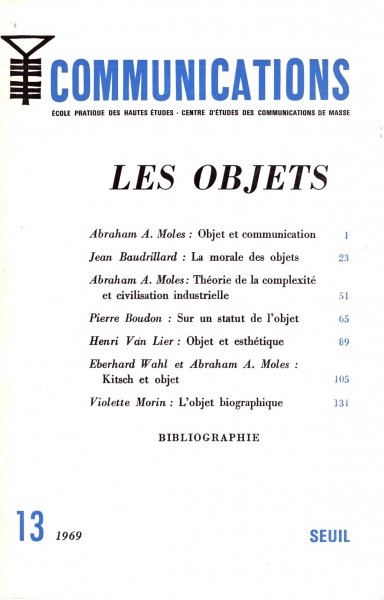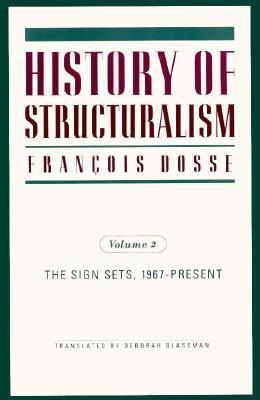Moles, Baudrillard, Boudon, van Lier, Wahl, Morin: Les objets (1969/71) [French, Spanish]
Filed under book | Tags: · 1968, aesthetics, design, object, philosophy, political economy, psychology, semiotics, sociology, theory

Communications is a biannual social sciences journal founded by Georges Friedmann, Roland Barthes, and Edgar Morin. Soon after its start in 1961 it became a reference publication for media studies and semiotics in France and internationally.
Its first 1969 issue was dedicated to the theory of objects, positioning it “at the confluence of sociology, political economy, social psychology, marketing, philosophy, design and aesthetics” (p 141). At the same time the journal argued for the relevance of the study of objects for governmental institutions such as “the Ministry of Industrial Production, the Ministry of Transport, the customs authorities, the courts, the counterfeits studies, or the National Industrial Property Institute” (p 141).
It can be read as a post-May 1968 attempt to use the concept of object as an agent linking social sciences in order to increase their impact on direct political change, and as well as an early echo of what more than a decade later came to be known as the actor-network theory.
Two years later the magazine appeared in its Spanish translation in book form.
Communications 13
Publisher Centre d’études des communications de masse, École pratique des hautes études, and Seuil, Paris, 1969
139 pages
Les objets (French, 1969), View online
Los objetos (Spanish, trans. Silvia Delpy, 1971/1974)
Thomas Harrison: 1910: The Emancipation of Dissonance (1996)
Filed under book | Tags: · 1910s, aesthetics, art, art history, avant-garde, expressionism, literature, music, music history, painting, philosophy, sociology

The year 1910 marks an astonishing, and largely unrecognized, juncture in Western history. In this perceptive interdisciplinary analysis, Thomas Harrison addresses the extraordinary intellectual achievement of the time. Focusing on the cultural climate of Middle Europe and paying particular attention to the life and work of Carlo Michelstaedter, he deftly portrays the reciprocal implications of different discourses—philosophy, literature, sociology, music, and painting. His beautifully balanced and deeply informed study provides a new, wider, and more ambitious definition of expressionism and shows the significance of this movement in shaping the artistic and intellectual mood of the age.
1910 probes the recurrent themes and obsessions in the work of intellectuals as diverse as Egon Schiele, Georg Trakl, Vasily Kandinsky, Georg Lukàcs, Georg Simmel, Dino Campana, and Arnold Schoenberg. Together with Michelstaedter, who committed suicide in 1910 at the age of 23, these thinkers shared the essential concerns of expressionism: a sense of irresolvable conflict in human existence, the philosophical status of death, and a quest for the nature of human subjectivity. Expressionism, Harrison argues provocatively, was a last, desperate attempt by the intelligentsia to defend some of the most venerable assumptions of European culture. This ideological desperation, he claims, was more than a spiritual prelude to World War I: it was an unheeded, prophetic critique.
Publisher University of California Press, 1996
ISBN 0520200438, 9780520200432
264 pages
Reviews (Martino Marazzi; Tyrus Miller; Daniela Bini; Christopher Hailey; Richard Mattin; Dennis Sexsmith)
Review (Laura A. McLary, Monatshefte)
Review (Thomas Kovach, Austrian History Yearbook)
Review (Marco Codebo, Carte Italiane)
Wikipedia
PDF (some images are missing)
View online (HTML, with images)
François Dosse: History of Structuralism, 2 vols. (1991–) [BR-PT, EN, ES]
Filed under book | Tags: · 1940s, 1950s, 1960s, 1970s, anthropology, history, language, linguistics, literary theory, marxism, philosophy, psychoanalysis, semiotics, sociology, structuralism, unconscious


“Claude Lévi-Strauss, Roland Barthes, Jacques Lacan, Louis Althusser, Jacques Derrida, and Michel Foucault—the ideas of this group of French intellectuals who propounded structuralism and poststructuralism have had a profound impact on disciplines ranging from literary theory to sociology, from anthropology to philosophy, from history to psychoanalysis. In this long-awaited translation, History of Structuralism examines the thinkers who made up the movement, providing a fascinating elucidation of a central aspect of postwar intellectual history.
François Dosse tells the story of structuralism from its beginnings in postwar Paris, a city dominated by the towering figure of Jean-Paul Sartre. The work of Saussure became the point of departure for a group of younger scholars, and the outcome was not only the doom of Sartre as intellectual leader but the birth of a movement that would come to reconfigure French intellectual life and would eventually reverberate throughout the Western world.
Dosse provides a readable, intelligible overall account, one that shows the interrelationship among the central currents of structuralism and situates them in context. Dosse illuminates the way developments in what are usually distinct fields came to exert such influence on each other, showing how the early structuralists paved the way for later developments and for recent discourses such as postmodernism. The cast of characters related by Dosse includes those mentioned above as well as Roman Jakobson, Julia Kristeva, Pierre Bourdieu, Gilles Deleuze, Félix Guattari, Tzvetan Todorov, and many others. Chapters are devoted to major figures, and Dosse has done extensive interviews with the major and minor figures of the movement, furnishing an intellectual history in which historical players look back at the period.
This first comprehensive history of the structuralist movement is an essential guide to a major moment in the development of twentieth-century thought, one that provides a cogent map to a dizzying array of personalities and their ideas. It will be compelling reading for those interested in philosophy, literary theory, sociology, anthropology, linguistics, and psychoanalysis.”
First published in French as Histoire du structuralisme, Éditions La Découverte, Paris, 1991, 1992
English edition
Translated by Deborah Glassman
Publisher University of Minnesota Press, 1997
ISBN 0816622418, 9780816622412 & 0816623716, 9780816623716
488 & 534 pages
Publisher (EN)
História do estruturalismo I (BR-Portuguese, trans. Álvaro Cabral, 1993, added on 2024-1-20)
História do estruturalismo II (BR-Portuguese, trans. Álvaro Cabral, 1994, added on 2024-1-20)
History of Structuralism, 1: The Rising Sign, 1945-1966 (English, trans. Deborah Glassman, 1997, via falsedeity)
History of Structuralism, 2: The Sign Sets, 1967-Present (English, trans. Deborah Glassman, 1997)
Historia del estructuralismo I (Spanish, trans. María del Mar Llinares, 2004)
Historia del estructuralismo II (Spanish, trans. María del Mar Llinares, 2004)

